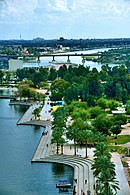Al-Hebnaa الهبنة | |
|---|---|
 View of Al-Hebnaa | |
| Country | |
| Governorate | Baghdad Governorate |
| District | Kadhimiya District |
| City | Baghdad |
| Time zone | UTC+3 (Arabian Standard Time) |
Al-Hebnaa is a neighborhood of the Al-Kadhimyah District in northern Baghdad, Iraq. It is located on the Karkh side of Baghdad, its boundaries being Muheit Street on the north, Mus'a Al-Kadoom Street on the east, Old Hebnaa Street on the west, and the rest of Al-Kadhimyah city to the South.
